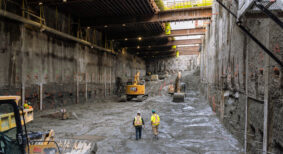In February 2011, an earthquake measuring 6.3 on the Richter scale rocked the City of Christchurch, New Zealand. The disaster caused widespread damage across the region, affecting the vast majority of buildings and infrastructure in Central City.
A report recently released from Swiss Re, a reinsurance company, found that similar to Christchurch, those living in Ontario, Quebec, and Atlantic Canada could face $30 billion in private residential losses should an earthquake hit. Unlike the West Coast, Eastern Canada has significantly older and heritage buildings that are not up to seismic code. Even earthquakes on a smaller scale could do significant damage. Regions like Eastern Canada face a harsh reality that their many buildings, constructed using materials that are not seismically durable, could not withstand even minor shaking.
Across the country, the West Coast of Canada is on the brink of the mass timber revolution. Vancouver is now home to the tallest mass timber tower in the world, located at the University of British Columbia. BC-based company, Structurlam,supplied the cross-laminated timber package. Prefabricated off site in Structurlam’s Penticton plant, the materials used in the construction of Brock Commons (photo) were known for being efficient, sustainable and seismically durable.
For Canada’s West Coast, the importance of seismic durability when it comes to construction is significant. Canada and the USA’s West Coast sits on the edge of two plates – the Juan de Fuca plate and the North American plate. This zone has the potential to produce an earthquake registering greater than 9.0 on the Richter scale.
As buildings continue to be constructed and “the big one” looms over the West Coast, building engineers and architects must consider what materials will support the reality of a significant earthquake. This has drawn many to consider building with cross-laminated timber (CLT) panels. As the height of mass timber buildings continue to climb, research is consistently demonstrating the ability of mass timber to stand up against seismic events and maintain their structural integrity.
The primary goal of constructing a seismically durable building is to minimize the amount of time the building is out of service after an earthquake occurs. In the event of Christchurch, 45 per cent of the buildings in the central city had to restrict access to the public following the disaster. Four years after the earthquake occurred, 1,240 demolitions had taken place within a four-block radius. The majority of these buildings were made of concrete. The reinforcing in concrete yields and can therefore not be relied on in the next event. This leads to the building being condemned and ultimately destroyed.
Where mass timber and CLT’s strength lies is in its durability against seismic forces. First and foremost, buildings constructed with CLT are lightweight. The weight of cross-laminated timber is six-times less than that of concrete. Seismically, this means the strength of an earthquake a building is designed to resist is directly proportionate to the weight of a building.
Research and testing has clearly demonstrated that mass timber and CLT structures can meet or exceed the most demanding earthquake and seismic design requirements. As residential and commercial development continues across Canada, building codes are adapting to ensure seismic durability. Building codes are now addressing the probability of an earthquake in any given region, as well as the possible severity of the event. Design requirements are made to align with the potential hazard. Engineers and architects are aiming to reduce the structural damage that could occur so that the building can be used as soon as possible following the disaster.
Building with cross-laminated timber is undoubtedly gaining momentum across North America. While mass timber is already being credited for being sustainable and cost effective, in regions such as Canada’s West Coast, the importance of seismic durability has never been more crucial.
As the threat of “the big one” continues to loom over the Pacific Northwest, action is being taken in the construction industry to ensure buildings have the most possible chance for survival. Cross-laminated timber has been a proven solution – complying with building seismic codes and demonstrating its ability to survive an earthquake.
Robert Malczyk is principal at Equilibrium Consulting Inc. in Vancouver.









